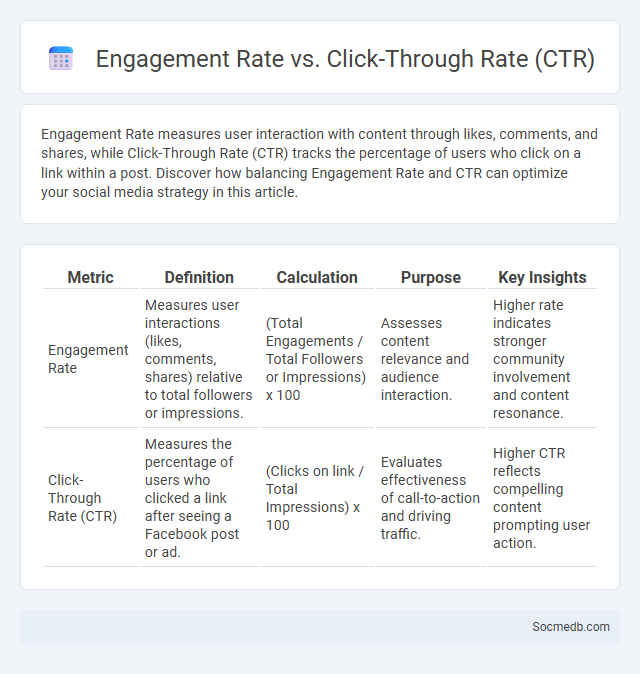
Photo illustration: Engagement Rate vs Click-Through Rate (CTR)
Engagement Rate measures user interaction with content through likes, comments, and shares, while Click-Through Rate (CTR) tracks the percentage of users who click on a link within a post. Discover how balancing Engagement Rate and CTR can optimize your social media strategy in this article.
Table of Comparison
| Metric | Definition | Calculation | Purpose | Key Insights |
|---|---|---|---|---|
| Engagement Rate | Measures user interactions (likes, comments, shares) relative to total followers or impressions. | (Total Engagements / Total Followers or Impressions) x 100 | Assesses content relevance and audience interaction. | Higher rate indicates stronger community involvement and content resonance. |
| Click-Through Rate (CTR) | Measures the percentage of users who clicked a link after seeing a Facebook post or ad. | (Clicks on link / Total Impressions) x 100 | Evaluates effectiveness of call-to-action and driving traffic. | Higher CTR reflects compelling content prompting user action. |
Understanding Engagement Rate: Definition and Importance
Engagement rate measures the level of interaction your content receives on social media platforms, including likes, comments, shares, and clicks relative to your follower count. High engagement rates indicate strong audience interest and content relevancy, driving better visibility through algorithms and fostering community growth. By analyzing engagement rate, you can optimize your social media strategy to enhance user connection and maximize campaign effectiveness.
What is Click-Through Rate (CTR)?
Click-Through Rate (CTR) measures the percentage of users who click on a link or advertisement after viewing it on social media platforms. A high CTR indicates your content effectively engages the audience and drives traffic to your website or landing page. Optimizing your social media posts and ads for relevance and appeal can significantly improve your CTR and overall campaign performance.
Engagement Rate vs CTR: Key Differences
Engagement rate measures the total interactions such as likes, comments, and shares divided by followers, reflecting audience involvement and content resonance on social media platforms. Click-through rate (CTR) calculates the percentage of users who click on a specific link or call-to-action, indicating the effectiveness of content in driving traffic or conversions. While engagement rate emphasizes user interaction and brand affinity, CTR focuses on direct responses and goal-oriented actions.
Calculating Engagement Rate: Formulas and Examples
Calculating engagement rate involves dividing the total interactions (likes, comments, shares) by the number of followers, then multiplying by 100 to get a percentage. For example, if a post receives 200 likes, 50 comments, and 30 shares with 10,000 followers, the engagement rate is ((200 + 50 + 30) / 10,000) * 100 = 2.8%. Understanding Your engagement rate helps gauge content effectiveness and audience interaction on social media platforms.
Measuring Click-Through Rate: Methods and Metrics
Measuring click-through rate (CTR) on social media involves tracking the ratio of users who click on a specific link to the total number of users who view the post or ad, providing critical insight into campaign effectiveness. Utilize tools such as Google Analytics, Facebook Insights, and Twitter Analytics to gather accurate click data, while monitoring metrics like impressions, reach, and engagement helps contextualize CTR performance. Optimizing your content based on CTR findings enhances your social media strategy, driving higher user interaction and improving overall ROI.
When to Use Engagement Rate vs CTR
Engagement rate is ideal for measuring how actively users interact with content through likes, comments, shares, and reactions, providing insights into audience connection and content relevance. Click-through rate (CTR) is best used to assess the effectiveness of calls-to-action and how well content drives users to a specific link or landing page, reflecting audience intent and conversion potential. Marketers prioritize engagement rate for brand awareness and community building, while CTR is critical for evaluating campaign performance and lead generation.
Factors Affecting Engagement Rate and CTR
Social media engagement rate and click-through rate (CTR) are influenced by content relevance, audience targeting, and posting time. High-quality visuals and compelling calls-to-action significantly boost user interaction and click behavior. Platform algorithms also play a crucial role by prioritizing content based on user preferences and past engagement patterns.
Interpreting Engagement and CTR Data for Campaigns
Interpreting engagement and click-through rate (CTR) data for social media campaigns reveals audience interaction patterns and content effectiveness. High engagement metrics such as likes, shares, and comments indicate content resonance, while CTR highlights the percentage of users taking desired actions like visiting landing pages or product sites. Analyzing these metrics helps optimize targeting strategies and creative elements to maximize campaign ROI and user conversion.
Optimizing Content for Higher Engagement Rate and CTR
To optimize content for higher engagement rate and CTR on social media, you should leverage eye-catching visuals, compelling headlines, and clear calls to action that resonate with your target audience. Ensuring your posts are tailored to platform-specific algorithms and user behavior increases visibility and interaction. Regularly analyzing performance metrics allows you to refine your strategy, making your content more relevant and clickable to boost your overall social media impact.
Common Mistakes in Tracking Engagement Rate and CTR
Common mistakes in tracking social media engagement rate and click-through rate (CTR) include relying on incomplete data sets and ignoring campaign-specific metrics, which can lead to inaccurate performance analysis. Many marketers overlook the impact of bot traffic and fake accounts, causing inflated engagement rates and misleading CTR figures. Failure to segment audiences properly and not accounting for platform-specific measurement standards further distort the true effectiveness of social media campaigns.
 socmedb.com
socmedb.com